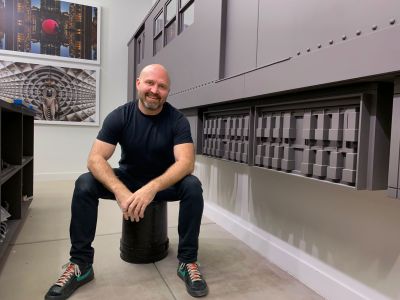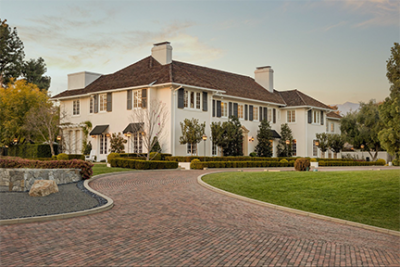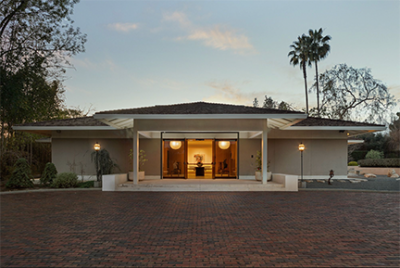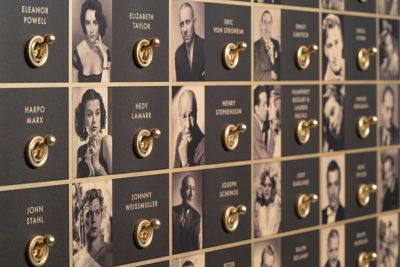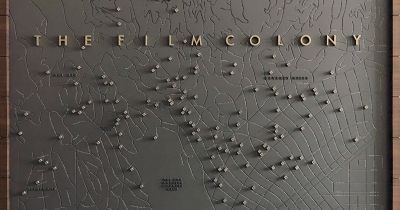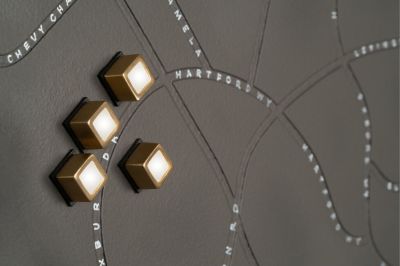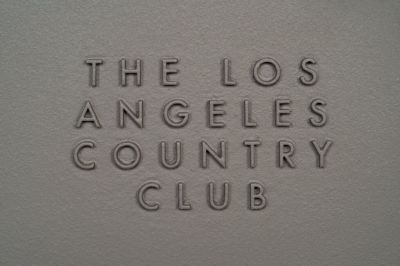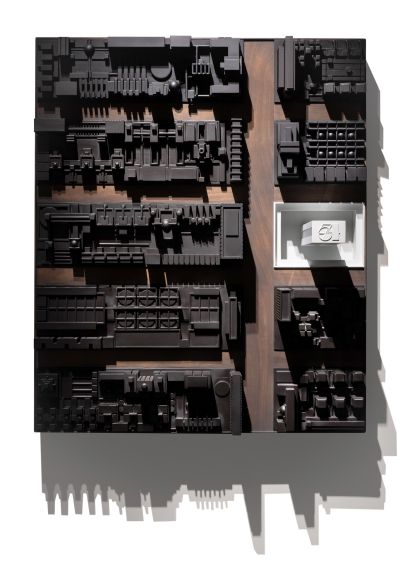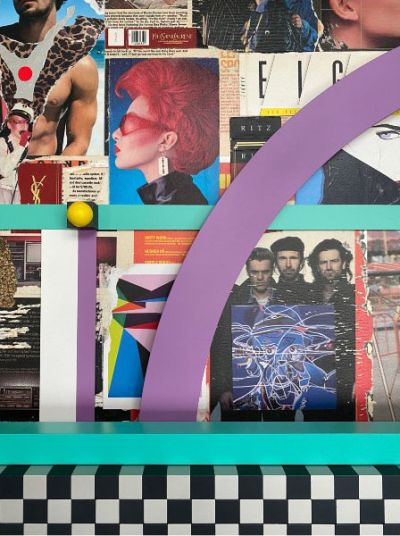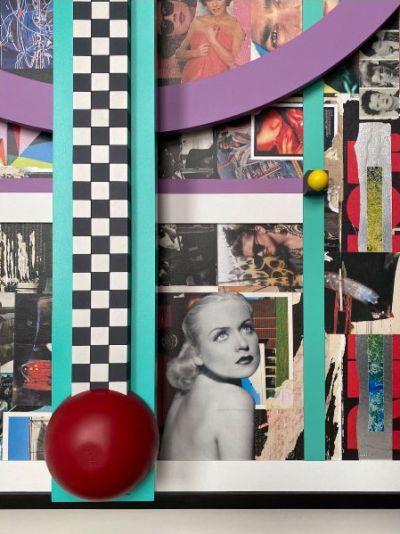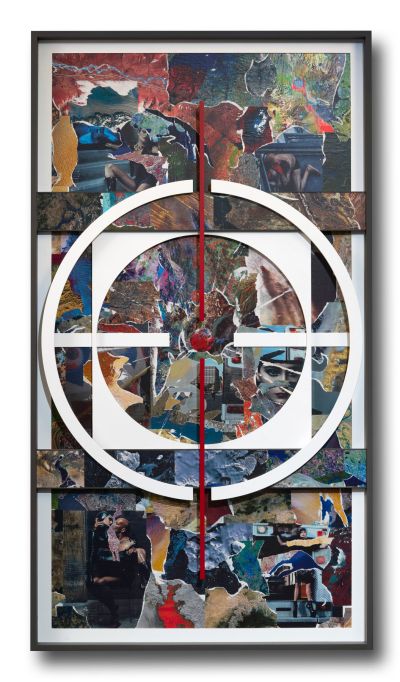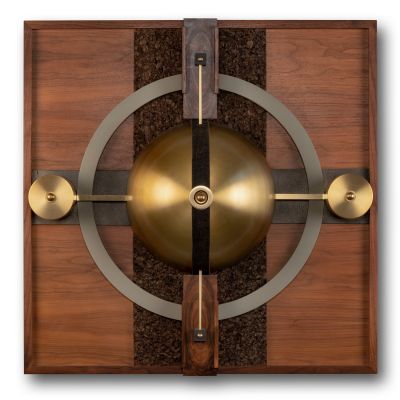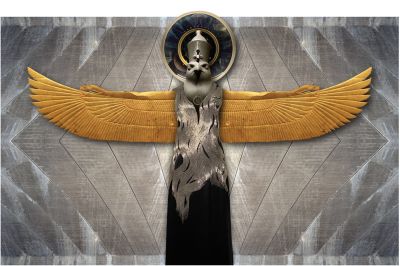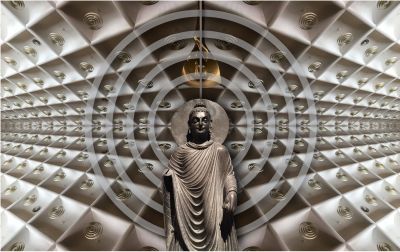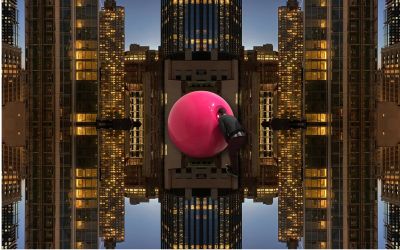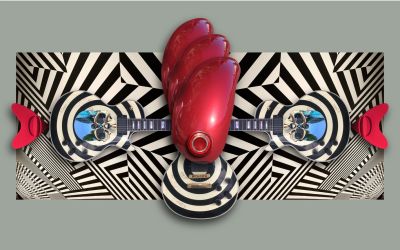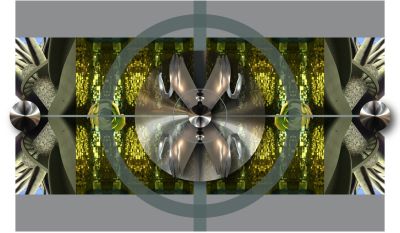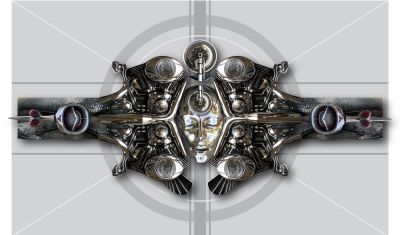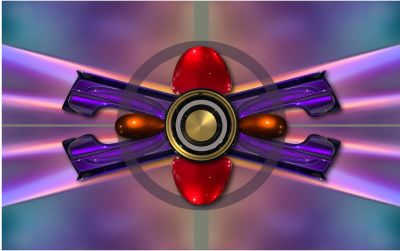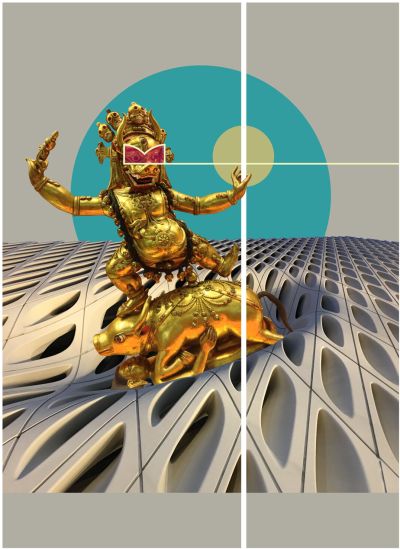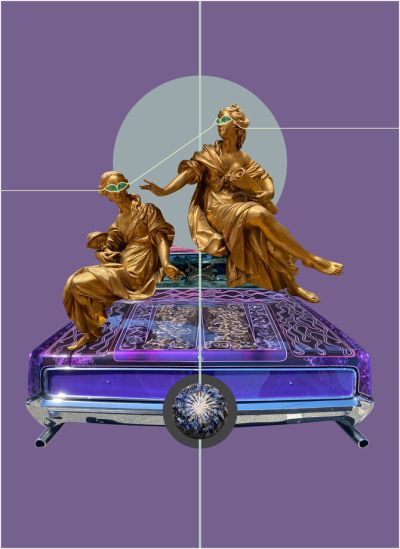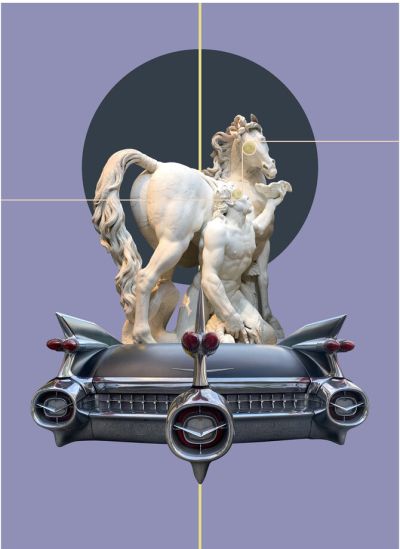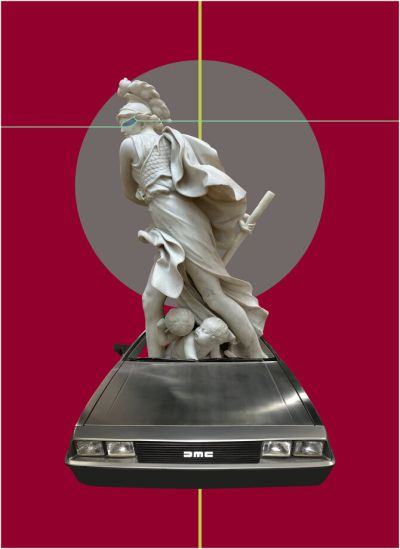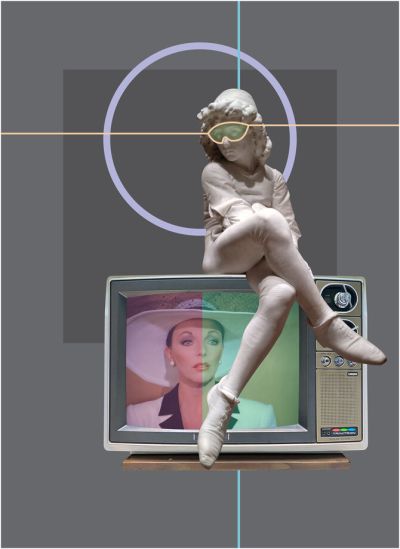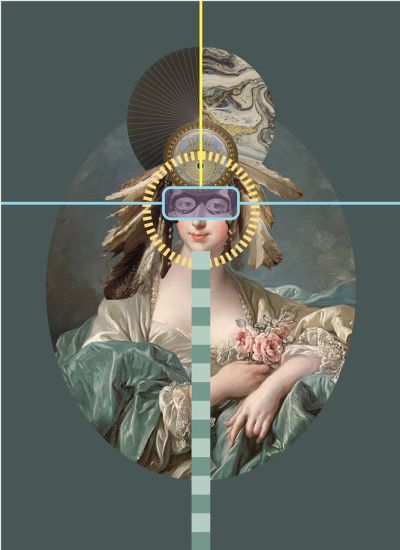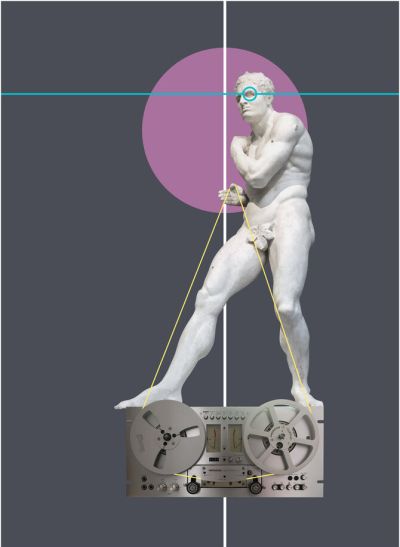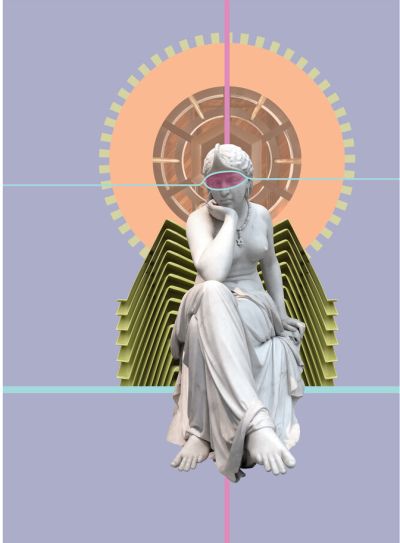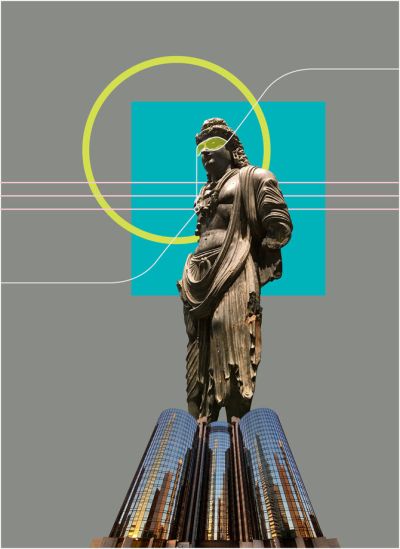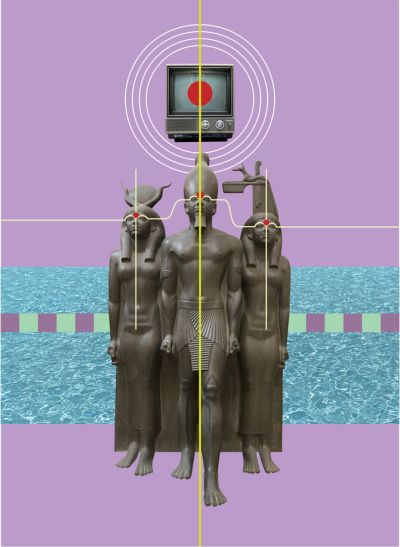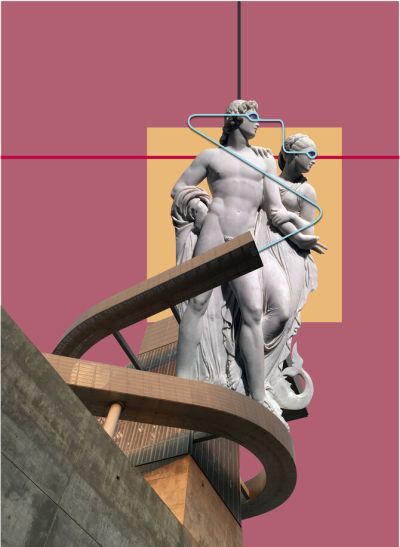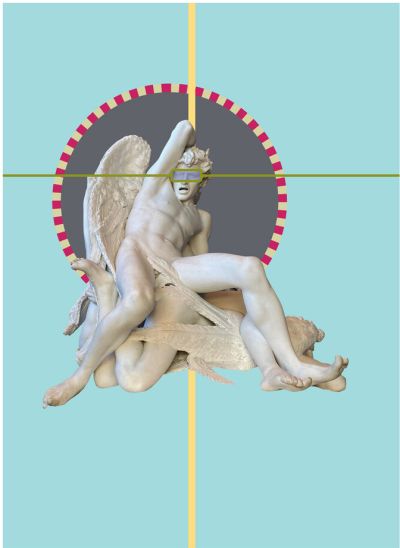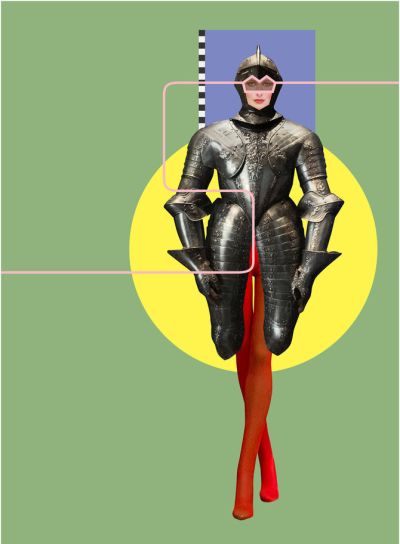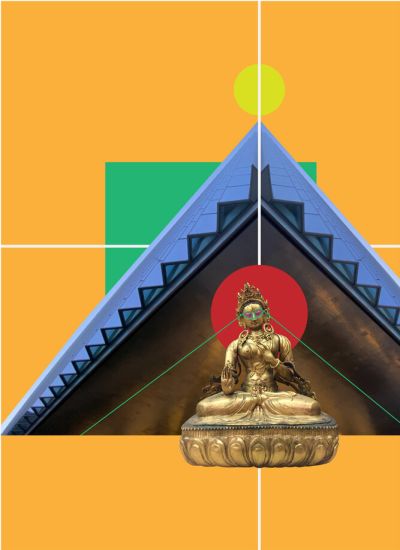Once upon a time, my big mouth on the Internets captured the attention of Matt Locke, one of the most talented designers you ever saw appear on HGTV shows like Design Star and Showdown, and we immediately forged a friendship that has spanned the past fourteen years.
Along the way, I’ve posted that in addition to being a gifted designer and meticulous craftsman, he’s also an accomplished artist who’s exhibited his sculptures at Dwell on Design in LA, and Colorado’s Cherry Creek Arts Festival, one of the best-attended arts festivals in the country. Now his work as an artist is getting the glow-up it so richly deserves, installed as a complete collection in a world-class private art museum on the grounds of the Knoll House in LA, currently listed on the real estate market for a cool $38.5M.
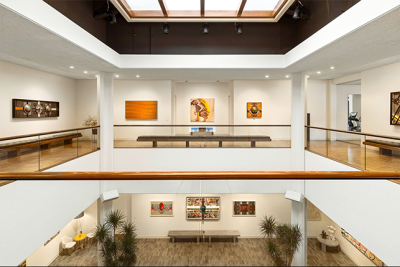
Knoll House art museum, featuring works by Matt Locke and Jennifer King. Photo by Cameron Carothers.
It turns out, while we were all making sourdough bread and avoiding relatives during a year that will live in infamy, Matt Locke was knuckling down and getting to work. “I have a voice,” he told me. “I’ve heard it my whole life. It speaks rarely, but always clearly. It comes at times when I’m not always expecting it, but it’s always right.” During the summer of 2019, while working on non-commissioned art for the first time since he moved to LA in 2005, Locke’s intuitive voice told him, “Finish this art, pay off your debt, and get ready to move, because this is all going away.”
Within months, he lost his job in construction project management thanks to the global shutdown, moved out of his loft in the arts district with its crippling rent, and found himself with “nothing to do and nowhere to go except make this art.” He moved in with friends, found a space where he could build out a workshop, and got to it.
The Knoll House Exhibition
When curating a private art museum (as one does), installing the right collection of original works would be key to showcasing the 21,000 square foot art museum on the property.
Twenty. One. Thousand. Square. Feet.
If you’re a legendary painter and sculptor and you also happen to be one hell of a rich broad, like previous owner/artist Virginia Steele-Scott, I guess you can build yourself a damn temple if you want.
In charge of staging the main Knoll House, interior decorator Matthew Finlason (HGTV’s The Stagers, Selling LA), needed to curate the space and fill it with art. “The estate was partially furnished, incomplete, and its creative soul tethered,” says Finlason. “I was tasked to complete the decorating, color block its palette, finish its interior, and bring the home to life, marrying both classical design and ‘art deco Gatsby.'” Which is why Locke’s work is such a great fit in this particular property. There’s definitely an art deco vibe there.
Inspiration
While producing this body of multimedia art, “I did feel this force,” Locke says. “I had this vitality and life in me.” As a viewer, you can feel the underlying hum of that controlled force when you experience the work yourself, and this collection is the embodiment of Locke’s life and mentality. “I’m impossibly seduced by glamour,” he says, but he’s also the type of person whose idea of a great afternoon is spending hours in front of his computer, meticulously converting maps into an exacting myriad of vector lines in Adobe Illustrator. He’s obsessed with infrastructure and minutiae, and also has “a deep nostalgia for lost eras.”
“My work is technical and precise. The divisions are razor-sharp—I respond to these clear divisions of objects. There’s a curiosity about materials, the creation of the Universe, how technology works, and our relationship as humans to it. I want to know what’s behind the layers. I’m very intrigued by the process of building things. I love to dig into that.”
And dig, he does. “There are 436 open tabs on Safari on my phone right now, and they all have something I’m curious about—all of them.”

You’ll notice recurring use of domed shapes in a lot of Locke’s work, with crosshairs peeking out from behind them, and he likens this repetition to the compulsion of Richard Dreyfus’ character to create conical mounds in Close Encounters of the Third Kind. “That bull’s eye keeps coming to me. When I was making this collection, there was no intention of repeating a motif.”
The Bauhaus being one of Locke’s greatest influences, Locke loves pure, simple geometry, and says, “putting shapes in their place—like Legos—is very satisfying to me. These ‘targets’ happen unintentionally, but they focus your energy and connect to you. I’m trying to shoot (the viewer) into the heart of the piece.”
The Art Collection
Locke’s work reflects that art deco sensibility and clear Bauhaus influences. He often crafts his work out of what I would call “handsome” materials, like walnut and brass. He once used black cowhide to depict the shimmering of water on a walnut recreation of a New York City subway map, to stunning effect. Incorporating interactivity with switches and miniscule LED lighting is a recurring theme. Above all though, Locke’s work feels sleek and sexy.
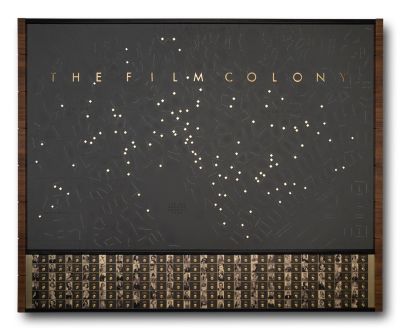
“The Film Colony,” by Matt Locke. Brass, leather, walnut, MDF, acrylic, LEDs, 78″ x 62″. Photo by Whitney Pratt.
The Film Colony notably incorporates portraits of Hollywood legends from the ’30s and ’40s, by George Hurrell. “I love their glittery, glamorous presentation—especially of women. I’m a sucker for it. I love the gossamer vibe of Old Hollywood—even more than the movies themselves. There’s a culture that was created that I’m just so enamored by—whether it ever existed or not. They were airbrushed to the gods. It’s always been fake, there’s always been a touched-up version, which I like. I love any effort by humans to make the best of something. Our bodies are prone to disease and trouble and heartbreak, and we treat each other like garbage…however, let’s make Joan Crawford look stunning and enjoy the movie!”
A carved MDF map of the stars, including their street names and framed in walnut, The Film Colony features brass-encrusted LED squares that light up to represent each of the featured stars’ homes when you toggle the brass switch of each actor and actress. It tapped into his fascination with maps and infrastructure. He loves how, “when you see it, you see how closely clustered they were, like a camp. It was a constellation.”
“There was a time, in the ’40s and ’50s where movie stars in Beverly Hills had no security gates and no hedges.” Locke explains. “You could walk right up to their front door. At the time, their PR people would happily publish their addresses for the star maps to use and when tour buses would come by, they might come outside with a tray of cookies, because it was good press. Those movie stars never worried about being murdered in their house. They never worried about being stalked. I don’t understand that world, because it’s not the America I grew up with. But in 1969, when Sharon Tate was murdered by the Manson Family in that house on Cielo Drive, that entire world disappeared, forever. And we’ll never get that back.” A lost era.
There are two pieces in the collection that are maps revolving around Studio 54. One (Come on Down to 54) is a three-dimensional bird’s-eye view of Manhattan skyscrapers in walnut, surrounding the infamous nightclub, with Studio 54 in white and “illuminated like a beacon.” The other (Only the Mob Makes More Money), is a stylized and backlit walnut closeup of the Midtown neighborhood, with a nude portrait of Jerry Hall “presiding over the location.”
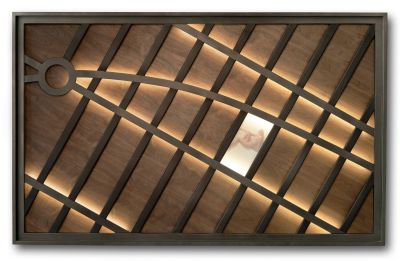
“Only the Mob Makes More Money,” by Matt Locke. Walnut, metal, leather, LEDs, 77” x 48”. Photo by Whitney Pratt.
“I knew about Studio 54 as a child, because of People Magazine,” Locke continues. “I never liked being a kid. I wanted to be 25, living in New York City and going to Studio 54 with Andy Warhol. Everyone who went there that I’ve met or read about said that when you were there, you felt like you had no problems. It was the most impossibly fun and glamorous place ever.
“As a kid, I watched TV incessantly. I’m surprised I was a good student. I was a pop culture fanatic and responded to glamour and advertising. I think I am so savvy and above it all, and I am absolutely not! I’m a complete sucker for a good, glossy ad. I’m embarrassed to admit that, but a lot of the work I’m making now is looking back and seeing just how vulnerable I was to ‘image.’
“New York—in my childhood—represented a bastion of art and culture and glamour and hedonism, which I’ve always loved, and I’ve always been obsessed with the city. It’s intense and dark and dramatic, which is what these pieces (“Come on Down” and “Only the Mob”) are. It was such a contrast to my suburban neighborhood in Colorado, although my parents were a little different in that they had built a disco dance floor in the house. Everybody I knew was married, nobody was involved in drugs, I didn’t hear people use racial slurs, all of us went to college. It was a bubble.
“At the same time, as beautiful as it was in suburbia, I never liked it—it wasn’t for me. I wanted more drama, I wanted to live among art and quirkiness and punk and grit. My work is born from the desire to get out of my repressed surroundings and be myself.
“I had no idea (at the time) how dangerous and expensive New York City was, but I saw Bianca Jagger and Cher at Studio 54 in People and I wanted to be there dancing. Unfortunately 54’s heyday lasted a very short time, because AIDS appeared and killed everybody, and the owner (Steve Rubell) was put in jail for tax evasion.
“Rubell was such a genius, the way he set up 54, but he was such an idiot with the press, telling them that he ‘made more money than the Mafia.’ When the IRS read that, they wanted their cut.”
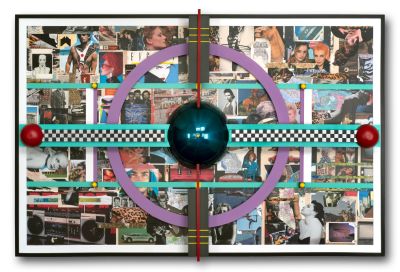
“Went Out,” by Matt Locke. Wood, brass, aluminum, magazines, LEDs, 72” x 48”. Photo by Whitney Pratt.
Went Out is a multimedia collage piece, featuring iconic celebrities from the ’80s, like Annie Lennox (a favorite of Locke’s), Boy George, and Madonna, as well as ’80s-era mainstays like boom boxes and Vans’ checkerboard. Can’t be my age and see a boom box without thinking of Say Anything.
A complete 180° aesthetically from the refined restraint of the walnut pieces, Went Out is an explosion of color and frenetic energy and takes stylistic inspiration from the Memphis School. It’s like my own generation’s memory banks writ large.
“My impression of the late ’70s was this dark and smooth glamour time and I thought it would continue,” Locke remembers. “But the following decade was this wild, loud ride where we were terrified of getting AIDS and dying. In spite of all the fear, I loved the ’80s. I dyed my hair black and smoked cigarettes on top of my asthma. I lived abroad as an exchange student and became fluent in French—I thought I was so cool!
“I think everybody looks back on their teen times with some nostalgia, and the world we’re in now, I don’t connect with. I’ve been waiting for something to come along and really grab my heart or my soul in any of the artistic fields and it’s not really happening—I feel like I’ve already seen it all. So what I’m doing instead is making my own. If I can pour all of my feelings into a piece and have it touch someone, that’s art. This collection is hard to classify, but I think I’m onto something. I want to be the person who’s presenting what’s new.”
With a title like Stayed Home, it’s not a mystery that Locke found inspiration from his pandemic experience. “It’s chaos control,” Locke explains of the analog—not digitally manipulated—creation. “It felt to me like the Earth was trying to get rid of us and we were saying, ‘no, we’re not going down!’ The humans in this collage represent anguish to me. Dark, and in some cases, bound.
“There’s a kind of power exchange that goes on between the couple featured in this piece, and the bull’s eye is the human response to the pandemic. I made that piece right at the beginning of the lockdown.”
Those humans playing out their wildest S&M fantasies in this case are no ordinary schmoes, though. That’s another pop culture reference, this time featuring Bruce Willis and wifey Emma Heming Willis caught up in black leather. Locke used torn collage pieces of NASA’s satellite images of the Earth, layered in covid-era imagery (an ambulance and a hospital) and superimposed them over spankin’ hot images taken by Steven Klein for W Magazine that Locke saved from 2009.
“My father died of covid pneumonia, so I was personally very affected by this and I’m not trying to make light of all of the human suffering,” Locke says. “But the general response was so mixed, and there were so many people who thought it was a hoax. That piece memorialized the anguish I felt in March and April (2020).”
Woke Up is about Locke’s parents, who he saw as two equal partners.
Ted Locke was an architect and did construction. Along with his wife, Holli, the two of them physically built the house Matt and his sister grew up in. As a septaugenarian, Ted built an addition to the house the couple lived in later. Says Matt, “My dad worked like a horse—lived to be 78 and never spent a day in the hospital. He didn’t fuss. He’s not who you would expect to build a disco dance floor in his house, but he did!”
Holli Locke worked full-time, had two kids, and put herself through art school. It took her twelve years to get her bachelor’s degree in art. “She took us to class with her when we were kids,” Matt recalls. “That’s how I learned about Louise Nevelson. My mother loved her and so do I.”
As a kid, Matt saw his parents living a rich and full life—including all of the trappings they wanted, including a family, creative careers for both of them, shared interests, and a tight circle of friends. “In the ’70s,” Matt reveals, “my parents were at the center of a neighborhood disco circuit. As children, we would be sent away for the night and they would have these wild disco parties!”
Watching all of this in the ’70s, Matt had an epiphany. “The target (in Woke Up) is about me waking up to the possibility of having the life that I wanted. That’s why it’s done in ’70s materials, like cork and brown wood. It’s a tribute to them in that era. Some people see it as a portal.”
Additional Multimedia Work
I would be remiss if I didn’t share three of my all-time favorite commissioned pieces Matt has created in the past that we didn’t have a chance to chat about:
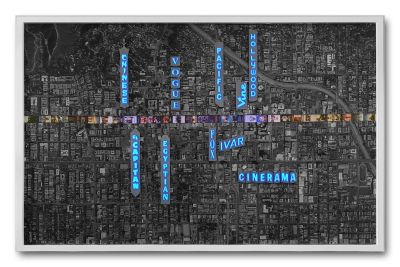
“Hollywood Moviehouses,” by Matt Locke. Dibond, acrylic, wood, LEDs, 72” x 48”. Photo by Matt Locke.
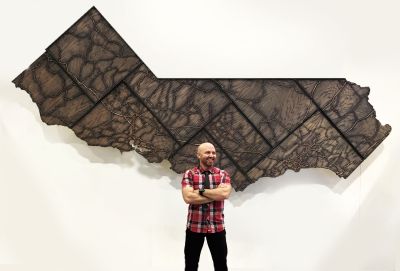
“California Freeways,” by Matt Locke. Oak plywood, copper, staples, 192″ x 96″. Photo by Matt Locke.
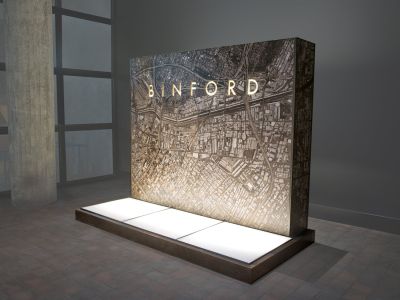
“Binford,” by Matt Locke. Walnut plywood, steel, acrylic, LEDs, 96” x 18” x 96”. Photo by Matt Locke.
Photo Collage Prints
Oh, and while Matt was doing all this, he also went through 25,000 of the photos he’d taken with his iPhone over a decade from all points of the globe, pulled out 800 of his favorites, and constructed two series of collages. You can buy prints of them on paper, metal, or canvas, as well as T-shirts, phone cases, magnets, and acrylic trays emblazoned with the collage(s) of your choice!
To see more works, inquire about pricing, or purchase prints of his photo collages, visit multimedia artist Matt Locke’s website. If you happen to be in the Los Angeles area and would like to arrange a viewing of these and other works, contact Matt Locke directly—but be quick about it. Once the Knoll House sells, you won’t be able to see this complete collection in this exclusive venue!

